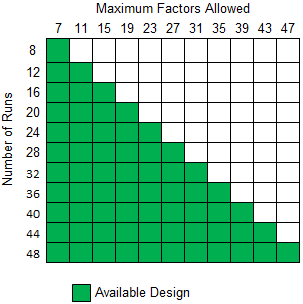Plackett-Burman Designs
Plackett-Burman designs are highly fractional designs that allow you to consider a subset of combinations of up to 47 factors at two levels each. Unlike two level fractional factorial designs, the number of runs in Placket-Burman designs is a multiple of four (rather than only a power of 2), and the number of factors can be up to one less than the number of runs (e.g., an experiment with 16 runs can screen up to 15 factors). Because this design is highly fractional, it is not appropriate for studying interaction effects. The design matrix was developed by Robin L. Plackett and J. P. Burman in 1946.
Available Plackett-Burman Designs
The available Plackett-Burman designs are shown next. This information is applicable to designs with standard response data, as well as robust parameter designs and reliability DOE.

This table provides information about the available combinations of the number of factors and the number of runs. The number of runs in a Plackett-Burman design is always a multiple of four. The number of factors can be up to one less than the number of runs. For example, this table shows that a design using 20 runs may use up to 19 factors.